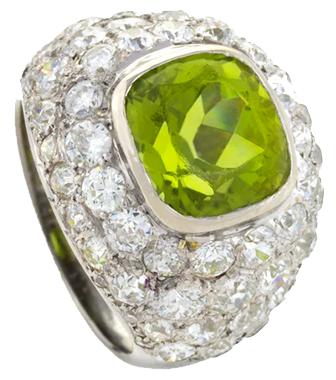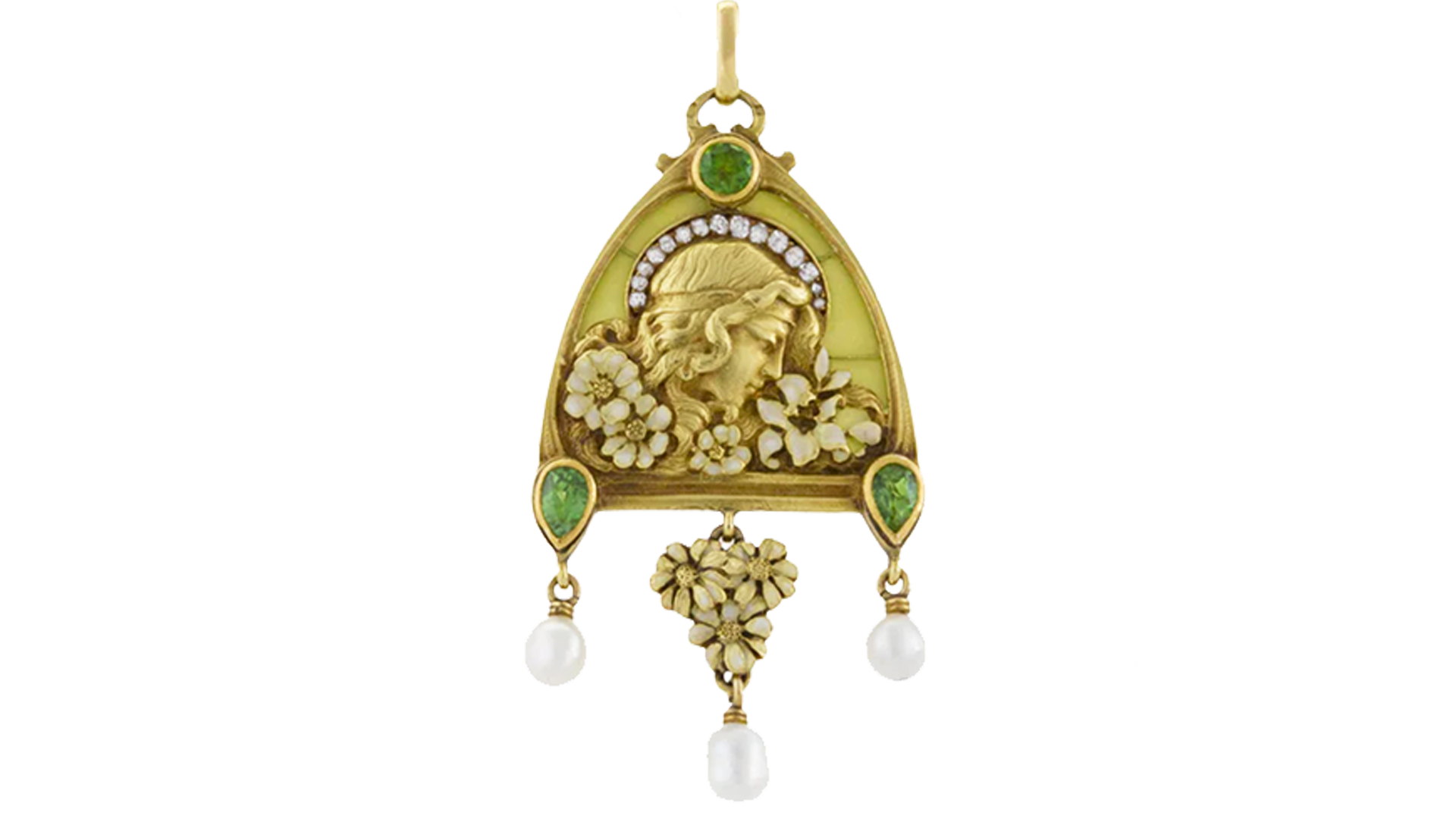What gemstone is buried deep in the earth’s mantle, falls to earth from meteorites and flows from lava in volcanoes? The answer is peridot, the luscious bright green gem that has a history dating back to the ancient Egyptians and was a favored gemstone for jewelry during the Victorian and Edwardian eras.

Mining for this kiwi green stone has been traced back to somewhere between 340-279 BCE. The ancient Egyptians originally found peridot on an island in the Red Sea, Zabargad (sometimes spelled Zeberget) and formerly known as Topiazius. Now known as St. John’s Island, it is located at the tip of the Red Sea and is a popular destination for scuba divers as it sits on a large reef system. In ancient times it was a major source of gems including peridot, which at the time was mistaken for other gems. Some historians even speculate that Cleopatra’s famed emerald collection was really peridot.
In an actual case of mistaken identity, the 200 plus carat peridot that adorns the Shrine of the Three Holy Kings, in Cologne, Germany were originally thought to be emerald. Peridot was highly valued in both ancient cultures and Medieval times and it showed up in the jewelry adorning priests as early as the Second Century BCE and in other church ornaments sometime later.
Peridot: The August Birthstone

The word for the August birthstone, peridot, comes from the Arabic word Faridat, which means gem. Besides being admired for its fresh grassy green color, peridot is considered to be a protective talisman. It is believed to stop nightmares and to induce positive energies that lead to happy relationships and a happy marriage, which may be why it is the gem associated with the 16th wedding anniversary. To fully manifest its powers, Roman historian and gemologist Pliny the Elder, stated that peridot must be set in gold. The Romans called the gem “evening emerald” because it glowed under candlelight rather than going dark at night, the gems shimmered and kept their color even in low light.
Peridot was a particularly beloved gemstone in the late Victorian era, known as the aesthetic years. The gem maintained its popularity during the Edwardian years, in part because allegedly green was King Edward VII’s favorite color and he declared peridot to be his favorite gem. It’s glowing hue was also complementary to the lightweight muslins and pastel colors that were favored during that time. The gem blended well with the white-on-white diamond and pearl jewelry that was fashionable during the early years of the twentieth century adding a pop of color to the monochromatic style. You’ll find peridot in Victorian, Edwardian and Art Nouveau jewelry as well as other design movements of that time.
Where is Peridot Found?

So where exactly do peridot come from? Unlike most other gemstones, it is found deep in the earth’s mantle and comes to the surface via volcanic explosions. It is also found in some forms of molten rock, including basalt. It is found in lava flows in Hawaii, China and Vietnam. There are also finds in Myannmar, Pakistan and Finland. One of the largest finds is on the San Carlos Indian Reservation in Arizona. Very rarely, peridot is found in meteorites that hit the earth. This is such a rare phenomenon that the peridot found in jewelry is not from this source.
Peridot, is a part of the olivine mineral family. It is has trace elements of magnesium and iron. It is the iron that gives peridot its color, which can range from a vibrant limey green with yellow undertones to a more subdued olive green with brownish undertones. The most desirable shade of peridot is that which is a pure green with no undertones. Peridot is found in volcanic rocks such as basalt as they are heavy in iron and magnesium. It is a 6.5 to 7 on the Mohs hardness scale, so peridot needs to be protected from heavy wear – don’t wear it while gardening, doing housework or playing sports. Clean your peridot jewelry gently with mild soap, warm water and a very soft brush or cloth. Let it air dry and store wrapped so that the peridot doesn’t get scratched by another stone.
Next time you’re looking at vintage or antique jewelry and you see a vibrant green stone, it just might be peridot, the other green gem.
Featured image (top of page): Art Nouveau 18-karat yellow gold, peridot, pliqué-a-jour enamel, natural pearl and diamond pendant depicts Shakespeare’s Juliet when spotted on a balcony by Romeo, courtesy Macklowe Gallery.
Authored by Amber Michelle
